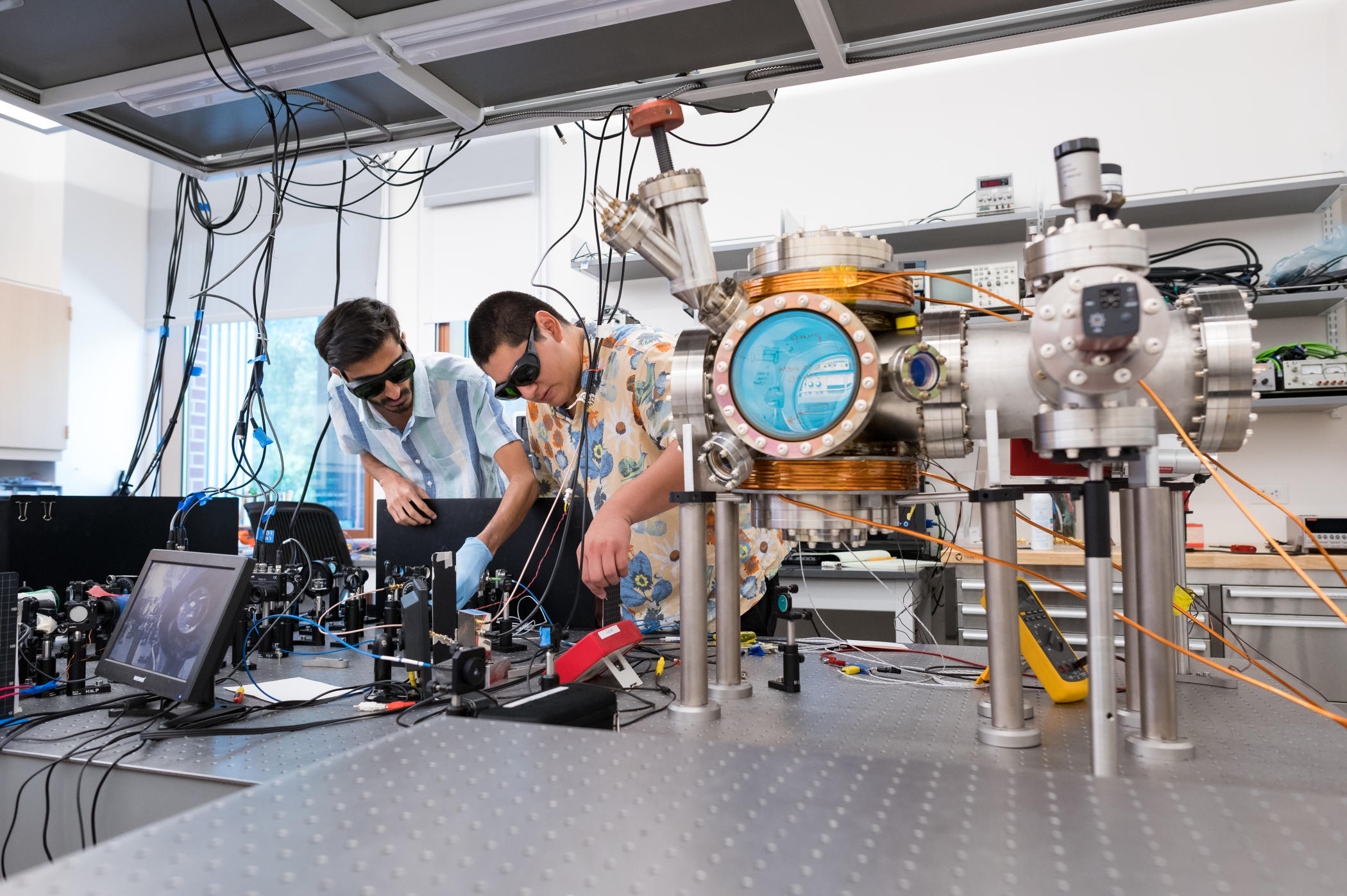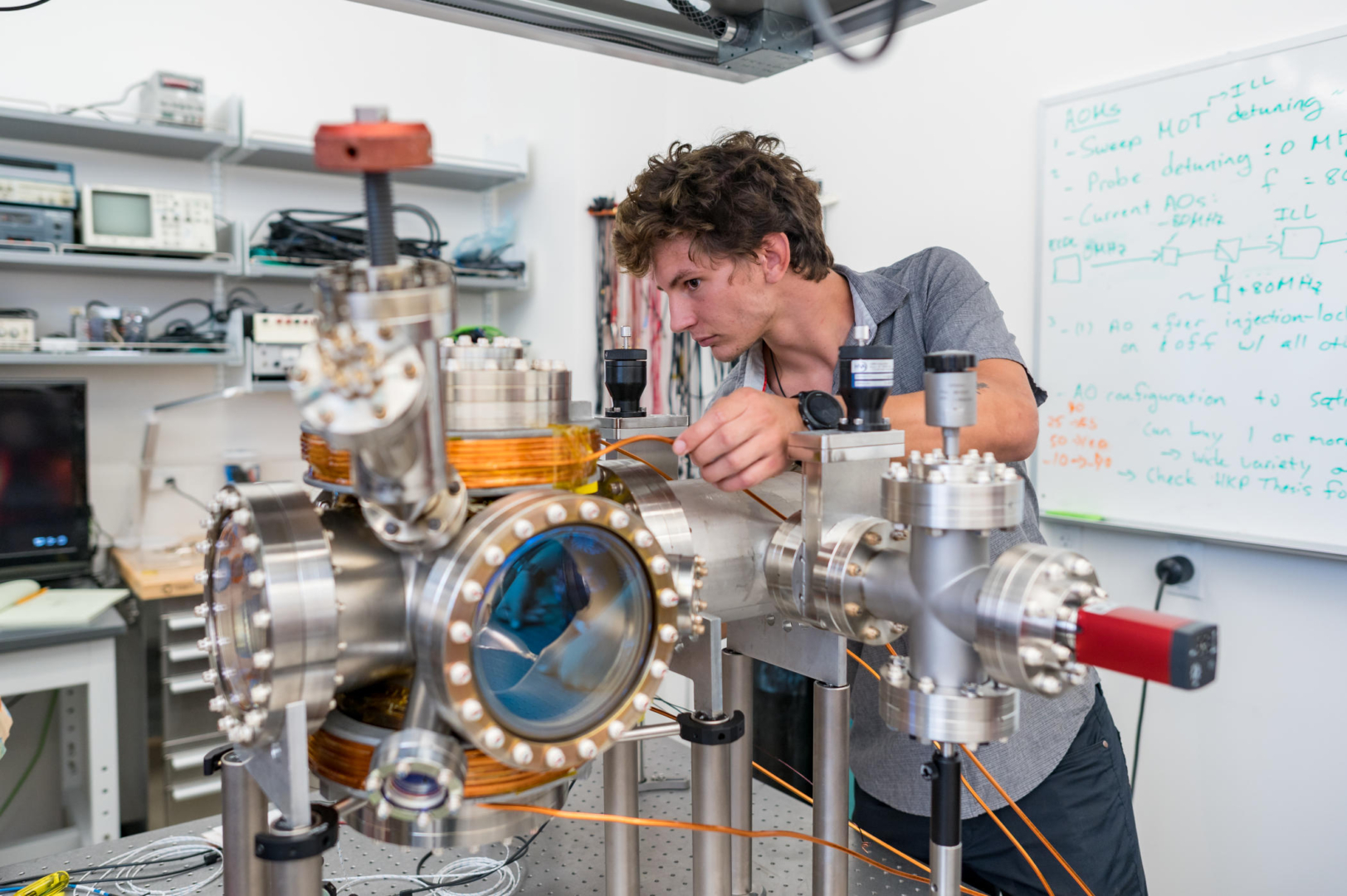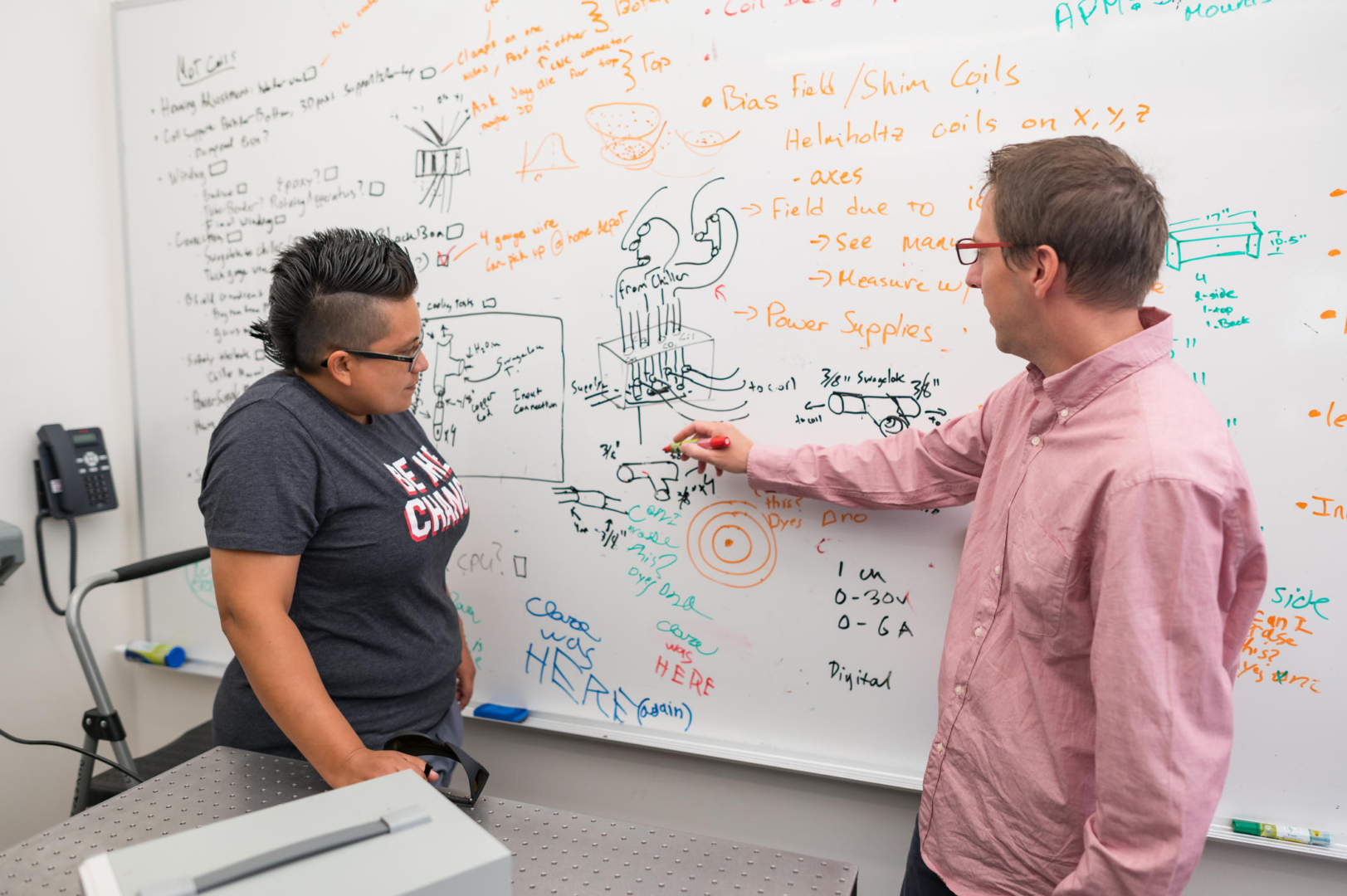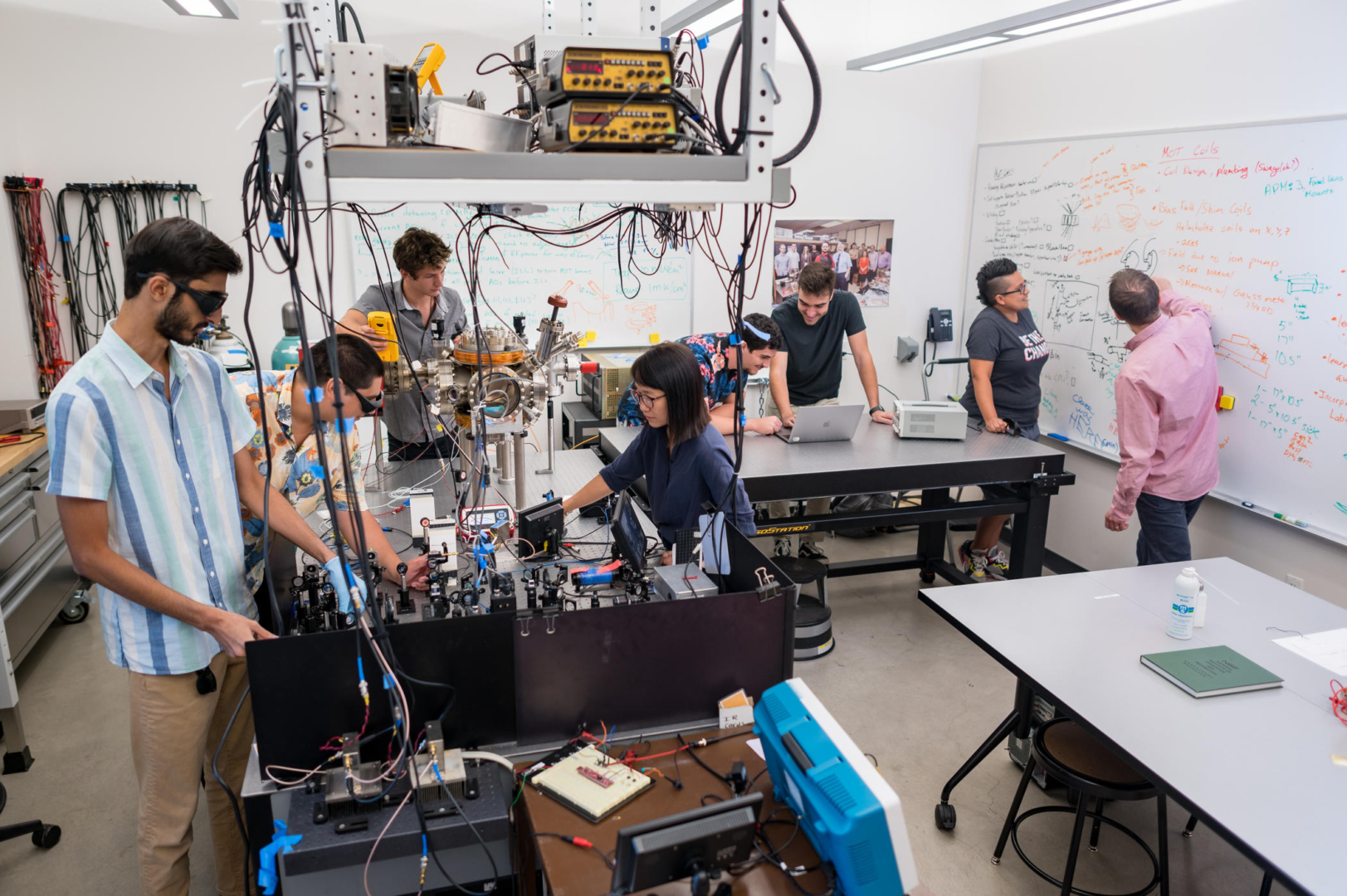Ultracold Atom Lab Attempting to Cross ‘Unreachable’ Threshold

Students Farhan Rehman (left) and Esteban Teran (right) work on research involving atoms cooled to “ultracold” temperatures engage in unique hands-on activities, from designing and implementing experiments to gathering and measuring data to probing and fixing problems when they arise in the hypercold lab on Thursday, September 1, 2022 in Chico, Calif. The cutting-edge technology in the ultra-cold atom laboratory—which includes a magneto-optical trap, lasers, and vacuum technology—will provide the groundwork for upcoming research to explore how gases and atoms behave when lasers slow them to a near-motionless state—a point near absolute zero temperature. (Jason Halley/University Photographer/Chico State)
The coolest place on campus just got cooler.
After an eventful summer and the dedicated work of nine students, physics professors Hyewon and Joe Pechkis are thrilled that the ultra-high vacuum (UHV) chamber in the ultracold atom laboratory is up and running—with an ambitious goal to set a first for the CSU system.
One of many innovative research opportunities in the Science Building, the lab features a magneto-optical trap, lasers, and vacuum technology, and reflects the vision for students from different majors to come together to nurture creativity in research. After years of preparation, faculty and students are finally using the lab to cool atoms to near absolute zero, nearly freezing them in space so they display their true quantum nature.
“The absolute zero threshold is not just unreached by our lab, it’s considered unreachable, period,” said physics major Esteban Teran. “It’s not just cold like the artic. We are going millions of times colder than outer space. Why even go cold? When you cool atoms to near this threshold, they stop acting like the atoms we know in our daily lives.”
Physics and mathematics major Farhan Rehman likes to compare the process to bowling. It’s as if a bowling ball is moving down the lane and ping-pong balls are being thrown at it to slow it down, the senior explains. The atoms are the bowling balls, and the light is the ping-pong balls. The goal is to keep hitting the atoms with light—and it will take a lot—until they finally slow down to a near-motionless state and behave more like waves. Pressure then becomes critical, as atoms will survive longer inside the chamber the lower it is and give the researchers more time to study them.
To reach this point represents years of dedication. Pechkis has been researching this subject for most of her career, but the project gained traction in 2017, when Nobel Laureate William Phillips donated a vacuum chamber as a pivotal piece of equipment to begin the lab’s construction in earnest. Since then, Pechkis has found additional grants, including an Early Career Award from the National Science Foundation to further fund its development, and secured gifts of materials from their colleagues from the National Institute of Standards and Technology (NIST).
By fall 2021, assembly and students began preparing to get the chamber ready. The bulk of the endeavor took place in June and July, as they completed the assembly of the vacuum chamber without any leaks—meticulously checking nearly 300 bolts to ensure a perfect seal.

Next, they pumped all the air and impurities out of the chamber and reached a final pressure of 10-10 Torr (0.0000000001 Torr). To do so, students took overnight shifts while the chamber was baked at 200 degrees Celsius for a few days. Despite a hiccup when a pump cable was damaged while baking, they were able to proceed as planned and achieve far more than what they had aimed for, including design and completion of the magnet field coils, which will allow them to create ultracold atoms.
“This pressure might be hard to imagine, but you could imagine it’s a similar pressure to that of outer space,” Pechkis explains. “For reference, our atmosphere is about 760 Torr.”
As atoms are cooled to these “ultracold” temperatures, Pechkis said they begin to behave like waves, according to quantum physics.
“Once cold, these gases have unique properties that make them excellent candidates for building quantum computers which, if developed, would be able to perform computations much more quickly than today’s classical computers,” she said.
She added that real credit for this project goes to the students.
“Not only are they brilliant, but they have a great passion, dedication, and amazing mindset,” Pechkis said.
Mechatronic engineering and physics major Gabriel Delich, mechanical engineering and physics majors Samuel Smith and Toni Grubisec, and electrical engineering and physics major Justin Craven, led the design before it was assembled and calibrated. Assembly was definitely a process of trial and error.
Key to its construction are two wire coils evenly spaced apart with the same current running in opposite directions. The slightest differences can create imbalances and hinder the cooling process, and then there were unexpected challenges with insufficient magnetic field strength and concerns about overheating. However, from these challenges, Craven came up with a more creative design using two pairs of magnetic field coils, which solved both of the problems of insufficient magnetic field strength and overheating. They made a lot of mistakes, but they learned so much in the process.

“You get to apply knowledge that you don’t have any other way to apply,” said computer engineering major and physics minor Yolanda Reyes. “I can’t do this at home.”
Chico State may not offer PhD programs or have the reputation of other schools in relation to its lab and research opportunities, Reyes noted, but said that in their experience, it’s been even better. After a summer internship at CalTech, at Chico State they have found opportunities to engage with other students, work side-by-side with faculty, and take an active role in problem-solving, Reyes said.
“The support is better and the ability to make progress is not stifled by bureaucracy,” they said.
This project has also impacted their classroom experiences, as the theory and experience build off one another, students said. For Grubesic, this experience has been exactly what he plans on doing with his career—taking a project, designing something, testing it, looking for opportunities for improvement.
“I’m thinking, ‘How does this fit into the overall experiment?’” he said. “A lot of the things I’ve learned in the classroom, I actually learned here first. And once you learn it in a lab, you can’t look at it the same way. You become infinitely curious about what you are learning.”
Now that the vacuum chamber is complete, the students are in the lab routinely working to cool atoms in the chamber. Flanked by a whiteboard covered in equations and notes and wires running neatly in every direction, like a well-designed intercity road system, they are constantly working with the lasers and designing the optical beam path into the vacuum chamber to cool the hot atoms as much as they possibly can.

The students’ work on this project, dating back more than five years, is nearly incalculable, but totals thousands of hours—basically the equivalent of a junior PhD, Pechkis said. And by bringing together students with physics, engineering, computer science, and mathematics backgrounds, everyone brought something different to the table.
The students agreed, saying they learned so much from one another in ways that would not always be typical in major-specific courses. They were also grateful for the donors and industry partners who made the acquisition of the equipment possible.
“Academia is very competitive,” Rehman said. “You want your name on the paper that wins that Nobel Prize. It’s heartwarming to know there are collaborators out there that just want the science to move forward and for students to be successful.”


